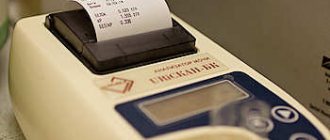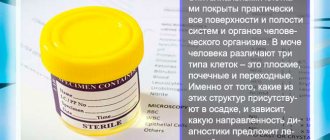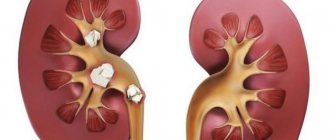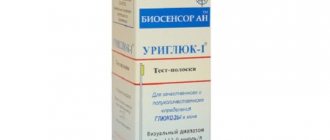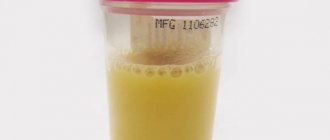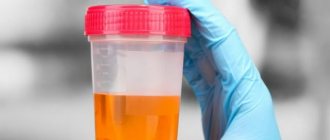Urine glucose test strips
Patients with diabetes need to regularly monitor the amount of sugar in the body, however, many people are frightened by the thought of invasive methods of determination.
Fortunately, nowadays there is an excellent alternative for detecting glucose levels in urine - special test strips for determining sugar in urine, which is especially convenient when diagnosing children. High levels of glucose in urine can be determined in a short time using test strips; their use does not cause any difficulties and does not require special knowledge.
How much do home diagnostic kits cost?
The cost of diagnostic strips consists of the number of applied reagents, the degree of their sensitivity, and the manufacturer. Mono-indicator strips cost between 180-500 rubles per pack. If a comprehensive urine analysis is necessary, multicomponent strips are used. Their price varies between 500-1400 rubles.
Indicator strips are a quick and affordable method for detecting changes in the biochemical composition of urine. They are used to monitor acid-base balance, creatinine levels, glucose and other indicators. Usually used by patients to monitor their general condition, metabolism and the dynamics of drug treatment.
Who needs test strips for sugar in urine and why?
First of all, a rapid sugar test is necessary for people with diabetes mellitus and a history of metabolic disorders that require monitoring glucose levels in the body.
Test strips can also be used if kidney pathology is suspected. Express diagnostics are suitable not only for humans - test strips are also used if it is necessary to monitor the condition of pets (cats, dogs) suffering from diseases with metabolic disorders.
Operating principle
The glucose test is a paper or plastic strip with a yellow indicator (sensor) applied on it, which, when immersed in urine, changes color as a result of an enzymatic reaction. The sensor reacts to sugar in the urine, the color varies from yellow (in the absence of glucose) to blue-green, depending on the amount of the analyte in the liquid.
Using indicator strips, you can determine other indicators of urine: protein, bilirubin, occult blood, nitrites, ketones, density, pH, etc. The Intermedica company offers a wide selection of equipment that meets international norms and standards, and experienced specialists will help you choose the type of test strips for urine analysis, suitable for all the necessary parameters.
Mode of application
The reliability of the result is ensured by proper preparation for express analysis and compliance with all stages of its implementation:
- The urine container must be thoroughly rinsed. The collection container must be clean and dry, without traces of detergent
- Urine freshly collected and thoroughly mixed
- Test strips for sugar in urine should be immersed without bending, so that the indicators are completely covered with liquid.
Now you can start analyzing:
- Collect urine in a container
- We remove the test strip from the tube, and then immediately close it tightly
- Dip the strip into the urine for 2-3 seconds
- Carefully remove
- Remove residual urine by lightly tapping the edge of the container.
- Place the strip on a flat, dry surface
- Wait 45-90 seconds (no more than 2 minutes)
- We compare the color of the indicator with the color scale on the tube or pencil case and evaluate the result. The analysis may not be reliable if the test strips for sugar are expired.
Why does ketonuria occur in children?
You can check the level of acetone in a child’s urine by conducting a series of laboratory tests.
In clinical settings, the Lenge test, Lestrade test, Legal test and modified Rothera test are performed. They are carried out exclusively for indications during pregnancy, to monitor patients with diabetes, to make an accurate diagnosis.
For analysis, it is necessary to take an average portion of morning urine to the laboratory.
The fastest diagnostic method is strips for determining the level of acetone in urine. Working with them is quite simple:
- immerse a strip coated with the reagent in a jar of freshly collected urine;
- remove the strip from the container and let it dry;
- The manufacturer includes a special color scale in the packaging, which is the decoding of the result.
Each strip from the package is used only once, stored in a closed box, touching them with your hands is unacceptable.
In order for the result of the study to be as correct as possible, it is necessary to prepare the baby for the delivery of biomaterial. If there are no express strips at home, then the biomaterial will need to be taken to the laboratory. It is better if it is the same organization where you constantly get tested.
Before collecting urine, the child needs to wash thoroughly and carry out all hygiene procedures. It is necessary to wash the baby with warm running water without using cosmetics. Otherwise, the result may be distorted even in healthy children. After the procedure, the child should be dried with a clean, dry towel.
It is better to collect urine in a disposable pharmacy container. It must be clean and dry. A medium portion of fresh morning urine is given. This condition does not apply to infants and children under one year old, since there is no way to control the process of urination.
On the eve of urine testing, you should not give your child fruits and vegetables that can change the color of urine. Exclude smoked meats, tangerines and honey from foods. Under no circumstances should you pour the collected liquid from a baby's potty into a sterile container, much less wring out diapers or diapers.
The collected biomaterial must be delivered to the laboratory within 1.5-2 hours after collection.
| Options | Norm values |
| Density | 1001-1004 g/l
|
| Acidity | From 5 to 7 in adults, 4-7 in children |
| Color | Straw yellow |
| Transparency | Transparent, slight turbidity is acceptable |
| Urine protein | Negative, the norm is considered to be up to 0.033 g/mol |
| Glucose | Absent |
| Bilirubin | Negative |
| Ketone bodies | Not more than 0.05 mmol/l |
| Hemoglobin | Absent |
| Amylase | Negative |
| Red blood cells | No more than 3 units |
| Leukocytes | In adults - no more than 3 units. In children and women, up to 6 units are permissible. |
| Epithelium | No more than 10 units |
| Urinary cylinders | None |
| Bacteria | No more than 10,000 per 1 microliter |
In addition, urine is examined for the presence of mucus, which should not be present, but a small amount is acceptable. The analysis can reveal the presence of fungal microorganisms that provoke candidiasis. Various salt crystals, phosphates, urates should not be present in the biomaterial. A deviation in any of the indicators is a reason to consult a doctor.
The norm for the content of ketone bodies in a baby’s biomaterial is considered to be zero. Even with the slightest deviation, the test strip will show a positive result. It is considered normal if the level of ketones does not exceed 0.05 mol/l or 20-25 mg per day. This amount of substance is not captured by the strips, since the volumes are negligible.
We can talk about the diagnosis of ketonuria only when all the signs and symptoms are present. If, apart from elevated ketones in the child’s urine, there are no manifestations of pathology, it is necessary to conduct a series of examinations to determine the cause of the deviation.
Ketones are formed during the breakdown of fats. This is a kind of intermediate product, which then goes to the kidneys and completely disintegrates there.
In the opposite situation, when the enzyme is not further processed, it accumulates in the body and becomes dangerous due to its toxicity. At the same time, the appearance of acetone in a baby’s urine is not always a serious pathology.
For example, minor jumps can be observed in children actively involved in sports.
This is due to a deficiency of glycogen - glucose, which is processed in the liver. The activity of children leads to the fact that all glucose is broken down, and enzyme deficiency occurs. Hence the sharp increase in ketones in the urine.
In addition, excessive consumption of fats and protein foods can become provoking factors.
When ketones in the urine are elevated, a specific ammonia odor appears. The reason for this may be the physiological characteristics of the development of the body or lifestyle. Such factors are considered to be non-pathological, that is, they do not pose a serious threat to health and are not considered signs of illness. These include:
- Daily physical activity. This is especially true for children involved in active sports.
- Prolonged, incessant crying.
- The child is tired, there are signs of overwork.
- Incorrectly formulated diet. The cause of metabolic disorders can be the abuse of fatty, spicy, salty foods. The phenomenon of ketonuria is often provoked by food with copious amounts of dyes. Thus, oversaturation with fatty foods can cause an acetonymic crisis.
- Insufficient volume of fluid consumed per day.
- Hot weather.
Signs of the disease caused by the above factors quickly disappear if the source is eliminated. If within five days the level of ketones remains the same, we are talking about pathological processes. Immediate assistance from a specialist is required.
Diabetes
Diabetes mellitus is a serious pathology in which not only the level of ketones in urine increases, but also a sharp jump in glucose occurs and sugar appears in the blood. Insulin deficiency occurs. This occurs due to the fact that glucose reserves are reduced to zero, and “sugar” starvation begins.
For further life activity, the body begins to look for a source of strength and energy. As such it takes fats. It is during the breakdown of fats that ketones are formed. Systematically checking urine ketone levels is a way to control diabetes.
In diabetes mellitus, the problem of acetonuria can only be solved by artificially administering insulin. If the disease is not kept under control, a serious complication of ketoacidosis develops, in which ketones in large quantities are not excreted from the body, wander and poison.
Other pathologies
The appearance of acetone in the urine cannot always be explained by a simple lack of carbohydrates. There are often more serious reasons. These include:
- infectious diseases accompanied by high fever;
- intoxication of the body associated with worms;
- intestinal infections accompanied by profuse vomiting and diarrhea;
- liver diseases, including impaired enzymatic function of the organ;
- problems with the endocrine system;
- head injuries;
- anemia, characterized by abnormal breakdown of red blood cells;
- malignant and benign tumors.
Treatment of ketonuria
The main goal of therapy is to eliminate the factors that provoke the pathology. There is not enough glucose - it is necessary to replenish the enzyme level.
To do this, you do not need any special injections; it is enough to have ampoules with a glucose solution that you can give to your baby to drink. If this is not possible, then you can get by with a pre-prepared raisin decoction.
To do this, a tablespoon of dried fruit needs to be steamed in a thermos, pour boiling water over it, let it brew, and after 10-15 minutes give it to the child as the main drink.
If the smell of acetone appears in the urine, a number of measures should be taken to eliminate the disease. The main ways to combat ketonuria are a strict diet and drug intervention.
In addition, to remove acetone from the body, it is necessary to give the child a glucose solution, sweet tea or still mineral water every 10-15 minutes. In the absence of vomiting and diarrhea, it is important to follow a certain diet.
Meals should consist of simple, easily digestible dishes with minimal fat content. Meals should be fractional. There is no need to force food on a child if he doesn’t want to. In case of severe vomiting, fluid replacement is considered the first priority. In some cases, injections are necessary. During illness, the following diet is strictly followed:
- Lean meat. Turkey, rabbit, and veal meat are ideal;
- First courses are required: light soups, chicken broth, low-fat cabbage soup.
- Non-dairy cereals.
- Low-fat fish varieties.
- Daily consumption of fruits and vegetables.
- Drinks that are welcome include weak tea, compote, and cranberry juice.
When treating ketonuria, the consumption of certain foods is strictly not recommended:
- canned food;
- fatty and spicy foods;
- smoked meats;
- citruses;
- baking;
- bananas;
- sour cream;
- heavy cream;
- cocoa.
All food is prepared only by steaming or boiling. It is better to offer all meat products to your baby in the form of meatballs or soufflé. The last meal should be no later than 7 pm. Low-fat kefir is considered the best drink before bed. Walnuts and hazelnuts must be present in a child’s diet.
To eliminate the cause of ketonuria, medications are often used. The main one is glucose in ampoules. If you don’t have one at home, you can use alkaline mineral water. The baby needs to be fed a teaspoon of sweet glucose solution every 10-15 minutes. The procedure is carried out until the acetone smell from the mouth disappears.
In the most severe cases, when there is non-stop vomiting, the child’s condition worsens and specialized medical care is needed. In stationary conditions, intravenous infusion of sodium chloride in combination with glucose is used. Cerucal is used in treatment as an antiemetic. Antibacterial therapy is prescribed in exceptional cases strictly according to indications.
As soon as the patient’s condition has stabilized, doctors will prescribe Regidron or Orsol, chamomile decoction and absorbent drugs. Drug treatment is carried out strictly in compliance with a special diet.
Summing up
Main advantages of test strips
- Accessibility – analysis does not require medical education;
- Ease of use – testing takes no more than 10 minutes;
- Painless. Express urine testing does not cause any discomfort.
- Wide range of diagnostics. Using tests for sugar in urine, you can also monitor kidney function in chronic pathologies.
- Long period of use. If storage conditions are met, tests from open packaging can be used throughout the shelf life.
- High accuracy. Test results are comparable to data from clinical medical laboratories. Strips are widely used to read indicators in Clinitek status and CL-50 urine analyzers.
- Economical. The strips are supplied in boxes of 100 pieces and the price of each individual monitoring will be lower than if you contact the laboratory.
The Intermedica company is a market leader in the sale of medical equipment and diagnostic equipment. In our catalog you can choose a test for sugar content in urine. Our representative offices sell only certified medical products with a guarantee of their quality.
Principle of operation
Glucose test strips are strips coated with a reagent, a chemical that reacts with glucose to change color, and topped with plastic and a separator.
Test strips are divided into qualitative and semi-quantitative. The first ones simply give a negative or positive result for sugar in the urine. The latter acquire a certain shade, which is compared with the scale on the packaging and indicates not only glucose, but also its level.
The default color of the urine glucose test strip is yellow (may vary for some brands), and if the result is negative, it does not change.
The chemical reagents of the test do not react to reducing substances such as ascorbic acid.
But the following factors can cause distortion of the results:
- taking medications that are excreted through the urinary system and kidneys;
- the presence of the oxidation product of salicylic acid – gentisic acid;
- poorly washed household chemicals from the dishes in which urine was collected for testing.
The result will be 98-99% if you avoid these factors and prepare carefully.
How to use it correctly
To determine whether a person suffers from glucosuria, you need to carry out certain manipulations with the test strip.
You can check your urine for sugar using it as follows:
- Urine should be collected in a sterile container.
- The strip is taken out of the package. Once opened, it should be used within 24 hours.
- The strip for testing urine for sugar is lowered down on the side where there are reagents.
- You need to wait 60 seconds, then take it out and check the result according to the instructions.
Please note that the urine should not have a strong sediment, be fresh (no older than 1-2 hours) and thoroughly mixed.
In a healthy state, human urine contains no glucose, or the amount is so small that no analysis or testing indicates its presence.
If after testing you receive a positive result, you should immediately consult a doctor and conduct a full examination.
Symptoms
There are three stages in the development of acetonuria, each of which has its own clinical picture. The mild form is accompanied by the following symptoms:
- strong feeling of thirst;
- abdominal pain;
- copious and frequent urination;
- You can smell a subtle smell of acetone from your mouth.
The pathological condition of moderate form is characterized by the following signs:
- the amount of urine decreases;
- blood pressure drops;
- urine smells like acetone;
- there is a disorder in the digestive tract (diarrhea accompanied by vomiting).
A severe form of acetonuria manifests itself with the following symptoms:
- wheezing when breathing;
- loss of consciousness;
- pain in the eyes;
- drying of mucous membranes;
- liver enlargement;
- peeling of the skin;
- increased body temperature;
- urination almost completely stops.
Excessive accumulation of ketone bodies in the body is accompanied by characteristic symptoms. You should immediately contact a medical facility and have your urine tested if the following symptoms occur:
- unpleasant odor from the mouth;
- increased fatigue;
- frequent nausea and vomiting;
- excessive pallor of the skin;
- decreased physical activity;
- loss of appetite.
Introduction
Diabetes is one of the most common diseases in civilized society. Even according to the most optimistic estimates, today there are from 50 to 60 million people suffering from this metabolic disorder (there are experts who believe that for every overt diabetic there is at least one hidden one). Therefore, the relevance of the diagnostic issue is very acute. As a rule, test strips for determining sugar in urine and special analyzers that react to glucose in urine are used for this.
Why do you need to test your urine if you have diabetes?
Diabetes mellitus is a general name for diseases associated with metabolic disorders, in particular, with impaired glucose absorption. These ailments are accompanied by strong urine output and excess blood sugar levels, which is caused by a failure in the production of insulin. Because of this, unprocessed glucose accumulates in the blood. This leads to so-called glucosuria.
With a modern lifestyle, many people are at constant risk of developing diabetes and, as a result, serious health complications, which is why the question of ways to detect malfunctions in the body is always acute. Considering the nature of the pathology, first of all it is necessary to examine urine or donate blood for analysis. To determine glucose in urine, special test strips for sugar in urine are used. Thanks to them, you can conduct a urine test right at home without going to the hospital, because you can purchase test strips at any pharmacy, which greatly simplifies diagnosis.
The test strips are made of plastic coated with special reagents and catalysts that react when combined with glucose. The presence of sugar in the urine indicates an abnormal level of sugar in the blood. The test is quite simple to use. In order to carry out the analysis correctly and avoid errors, you need to carry out the following manipulations:
- Collect urine in a clean and dry container,
- Immerse the strip with the side on which the reagent is applied,
- After a few seconds, pull it out,
- Clean the test from excess urine, preferably with laboratory filter paper,
- Wait at least one minute after applying urine to the reagents (otherwise the result will be underestimated) and a maximum of two minutes (otherwise the result will be overestimated),
- Compare the color of the strip with the scale on the package and assess your blood sugar level,
- If the urine has serious sediment, then it needs to be centrifuged for five minutes (this is difficult at home).
- If the conditions are met and everything is done strictly according to the instructions, then the accuracy of the test result will be 99%.
Can ketonuria be detected?
Only a chemical analysis can detect an increase in the level of ketone bodies in the body. The laboratory will immediately determine the level of ketone bodies contained in it.
In modern medicine, ketonuria is detected:
- Lange test;
- Legal sample;
- Lestrade's test;
- modified Rothera test;
- rapid tests;
Express tests are, of course, the most common. Their action is based on a chemical reaction, the result of which is visible almost immediately. All you have to do is place the test strip in your urine or drop it onto a test tablet. If the reaction is positive, the tests will turn purple. The brightness of the color allows you to judge on a special color scale how much the norm of ketone bodies is exceeded.
Using test strips
Test strips are an excellent alternative to donating blood. They are usually disposable. Test strips have a serious advantage, which is the convenience of doing the test yourself, without the need to go to the doctors. This helps to monitor your health at home and even on long trips, for example, in the mountains or forest.
At the same time, they are low in cost and can be easily stocked up if necessary. In addition to strips, biosensors are also used, which are also regularly used at home, but they are expensive and not so accurate, and have a number of errors. The main thing is not to forget about the expiration date and storage method; they should be kept in plastic boxes with a special desiccant. Strips should not be stored outside of sealed packaging for more than one hour. But biotests are different; there are a great many manufacturing companies, both foreign and domestic. This seriously increases their price. There are so-called “multi-tests” that allow you to run two different tests at the same time. For your reference, here are the following options:
- Bioscan (for determining acetone in urine) Bioscan is the name of one of the first domestic companies to develop test strips. Tests for Ketones (Acetone) stand out especially; they are not inferior to foreign analogues. The scale consists of five colors, the determination time is two minutes. At the moment the average cost is 115-120 rubles. It is worth considering when using acetone tests that acetoacetic acid may also indicate that the patient is hungry,
- Glucofan (for determining sugar in urine) Glucofan (GlucoPHAN) is a visual test of very good quality from a manufacturer from the Czech Republic, but it costs a little more. Measurement time – 60 seconds. Average cost 200-250 rubles,
- Diaphan (for determining acetone and glucose in urine), Another Czech strip is Diaphan. The peculiarity of this analyzer is that it is capable of “multitest”, i.e. do two tests at once, both for glucose content and for acetone content. Thus, it also has two scales for comparison. When using, it is very important to comply with storage conditions; the tightness of the box is very important. The price of this test is even higher, 300-350 rubles,
- Ketoglyuk-1 (for determining acetone and glucose in urine), This is a test with two indicators, but from a Russian manufacturer. The indicators are designed to react with acetone and glucose. Unlike its Czech counterpart, it has a very reasonable price for the Russian market of 140-150 rubles,
- Uribel (for determining protein in urine), Tests from a Russian company, but for determining protein content. Helps diagnose diseases related to the kidneys and liver. The price varies around 170 rubles,
- Uriglyuk-1 (for determining glucose in urine), Domestic visual sensors for determining sugar levels in urine are similar to the others. Available in packs of 100 pieces. Price 170 rubles,
- Uriket-1 (for the determination of acetone in urine), Diagnostic disposable indicators for the determination of acetone in urine. A product produced by the Russian company Biosensor AN. Acceptable price for Russia, around 135-170 rubles.
Treatment methods
The main goal of therapy for ketonuria is to get rid of traces of acetone in the body as soon as possible. Most often, men and women with this diagnosis are prescribed drug therapy, one of the most important stages of which is intravenous infusion with saline solution. If the content of ketones in the urine is not critical, therapy can be carried out at home.
The first thing you need to do to reduce the content of ketone bodies is to carry out detoxification using sorbents and normalize the water balance. The patient also needs to review his diet and adhere to a special diet that will help remove acetone from the body and prevent its further increase.
The diet requires compliance with the following rules:
- the patient needs to minimize the consumption of fatty meat, fermented milk products with high fat content, smoked meats and fast food;
- It is forbidden to eat sweets (chocolate, candies, jam, marshmallows);
- It is strictly prohibited to consume alcoholic beverages;
- It is recommended to remove citrus fruits, tomatoes and mushrooms from the diet.
A person's daily diet should include foods rich in fiber, all kinds of cereals and vegetable soups. Also, for ketonuria, compotes and fruit drinks made from fresh berries and dried fruits are very useful.
Preparation and conditions for analysis
Preparing for a urine glucose test excludes physical activity, consumption of foods with bright pigments, and stress factors the day before. The result is reliable if you use fresh biomaterial for research. Sugar levels change all the time and can differ several times.
If you conduct a urine test 1-2 hours after urination, the result will be irrelevant. Based on false data, the doctor may decide to reduce the dose of the drug, which will lead to a worsening of the person’s condition.
The person urinates in the toilet, drinks a glass of clean water, then is tested 30 minutes later.
The biomaterial is collected in clean, dry containers without any residual detergent or disinfectant. A sterile container purchased from a pharmacy is best suited for this purpose. To determine glucose, the volume of urine must be more than 5 ml, otherwise it will not be possible to dip the strips to the desired level.
The patient should test their sugar on an empty stomach because glucose levels rise after eating. Within an hour, it can be excreted in the urine even in a person without pathology.
The ambient temperature should be no lower than 15 and no higher than 30 degrees. Violation of this requirement leads to a longer reaction and data distortion.
The strip is sterile and must be used no later than one hour after removal from the container. To avoid contaminating the sensitive field, do not touch the indicator scale. Packaging with strips must be stored in a dark, dry place and tightly closed. You only need to check the results with the scale on the container or box. Shades may vary from manufacturer to manufacturer.

